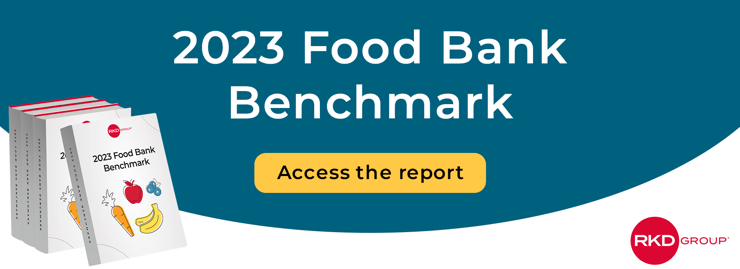Food banks closed out 2022 on a strong note, with active donors and revenue numbers still significantly higher than pre-COVID levels. But where do things stand after the first quarter of 2023?
In summary: Food banks continue to exceed pre-COVID levels, but we’re beginning to see trends stabilize and settle into their new, post-COVID normal.
As always, before we dive in, let’s discuss a few housekeeping items to help you understand our benchmarks.
About the report
We analyzed full-file data from 47 RKD food bank clients across the U.S. from Jan. 1 to March 31, 2023. Trends are based on all donors and all gift types, excluding gifts of $10,000 or more.
Each metric is indexed. We set 2019 as the baseline value of 100. Results in the following years are compared against 2019 and then averaged across clients, explaining the relative change in result for each benchmark over time.
Values over 100 indicate an increase over the value in 2019. Values below 100 indicate a decrease vs. the value in 2019. For example, an active donor value of 200 would represent a doubling in the number of active donors.
4 key learnings from Q1
1. Active donors and revenue trends continue to stabilize.
There was a surge in new and active donors in 2020, which drove record-breaking revenue numbers for food banks across the country. We all know those numbers began to taper off alongside the urgency of the pandemic. Even still, 2022 revenue was double what it was prior to the pandemic.
As we closed out Q1, revenue is settling into the new high, sitting 90% higher than pre-COVID levels.
In addition, Q1 active donors have stabilized at 52% higher than pre-COVID levels.
2. On average, donors are still giving higher gifts.
Average gift across all active donors was 22% higher in 2022 than it was in 2019. And first gifts were 25% higher than pre-COVID levels. We continued to see both numbers climb in Q1 2023, indicating the formation of new baselines for food banks.
3. Giving frequency is steadily on the rise.
New and active donor counts spiked dramatically during COVID. However, the shift to more frequent giving has been more gradual over the last four years.
Closing out Q1, giving frequency trends have settled into a new normal for food banks, sitting 10% higher than pre-COVID levels. As food banks continue to prioritize recurring gift programs, we’ll likely see this trend continue to grow.
4. Increased donor value is fueling revenue growth.
As we move into 2023, our Q1 trends are reflecting a new normal for acquisition. New donor volumes are sitting significantly below COVID levels but are 27% higher than pre-COVID.
However, as reflected in our full-year benchmarks, the donors who are giving first gifts continue to give at a much higher value, fueling revenue growth for many food banks. This is welcome news for food banks who are dealing with the double-edged sword of inflation—increased costs and increased need.
In summary, food banks are starting to see a stabilization of trends after record highs during COVID. While this is great news, 2023 will be a critical year for food banks as they build programs to support this new normal. A few areas we’re focusing on for our clients include:
- Building dynamic, omnichannel donor journeys
- Expanding digital investment
- Creating customized experiences for core donors
- Adding additional efforts targeted at lapsed audiences
You can read more about each here.






Leave a comment: